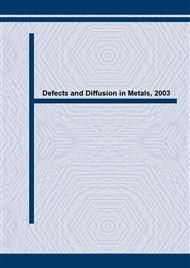[1]
J.D. Fast: Interaction of metals and gases, Mc Millan, Eindhoven, Philips Technical Library, 1971, Vol 2, Chs. 1. and 2.
Google Scholar
[2]
Y. Fukai: The metal-hydrogen system, Springer Series in Materials Science Vol. 21, Springer Verlag, Berlin, (1993).
Google Scholar
[3]
J. Völkl and G. Alefeld: in Hydrogen in metals I. ed. by G. Alefeld and J. Völkl, Topics in Applied Physics Vol 28, Springer Vlg., Berlin, 1978, p.321.
DOI: 10.1007/3540087052_51
Google Scholar
[4]
H. Wippf: in Hydrogen in metals III. ed. by G. Alefeld and J. Völkl, Topics in Applied Physics Vol 73, Springer Vlg., Berlin, 1978, p.51.
Google Scholar
[5]
R.G. Barnes: in Hydrogen in metals III. ed. by G. Alefeld and J. Völkl, Topics in Applied Physics Vol 73, Springer Vlg., Berlin, 1978, p.93.
Google Scholar
[6]
D.A. Faux and D.K. Ross: J. Phys. C.: Solid State Physics 20 (1987) 1441 8.
Google Scholar
[7]
J.R. Zimmerman and W.E. Brittin: J. Phys. Chem. 61 (1957) 1157.
Google Scholar
[8]
H. Pfeifer: In: NMR Basic principles and progress, 7. Ed. By P. Diehl, E. Fluck and R. Kosfeld, Sringer Vlg. Berlin, (1972).
Google Scholar
[9]
K. Tompa, P. Bánki, J. Garaguly, G. Lasanda and L. Vasáros: in Magnetic Resonance and Related Phenomena, Proc. of Joint AMPERE ISMAR Int. Conf. Berlin, (1998).
Google Scholar
[10]
K. Tompa, P. Bánki, M. Bokor, G. Lasanda: Europhys. Lett. 53 (2001)79.
Google Scholar
[11]
J. Crank: The Mathematics of Diffusion, Clarendon Press, Oxford (1956).
Google Scholar
[12]
P. Brill and J. Voitlander: Ber. Bunsenges Phys. Chem. 77 (1973) 1097.
Google Scholar
[13]
G. Bohmholdt, E. Wicke: Z. Phys. Chem., 56 (1967) 133.
Google Scholar
[14]
E. Serra, M. Kemali, A. Perujo, D.K. Ross: Metall. Mater. Trans. A, 29 (1998) 1023.
Google Scholar
[15]
H. Züchner, H. Berlag and G. Majer: J. Alloys and Compounds 330 (2002) 448.
Google Scholar
[16]
S.D. Axelrod, A.C. Makrides: J. Phys. Chem. 68 (1964) 2154.
Google Scholar
[17]
C.P. Slichter: Principles of Magnetic Resonance, Springer Vlg., Berlin, 1990 9 Legends Table 1. Diffusion coefficients Deff and maximal hydrogen concentrations [H]O obtained from fit of Eq. 6 to the measured [H] vs. t values (Fig. 2). The ratio Deff/D* accounts for the fraction of “free” hydrogen (Eqs 2 and 3), where D* is 8. 15 · 10 -12 m 2/s [13, 14]. Figure 1. Time dependence of hydrogen charging (up triangles) and discharging (down triangles) of Pd0. 75Ag0. 25–H at T = 296 K (upper graph). Lower graph: charging and discharging rates. Lines are guides to the eye. Figure 2. Theoretical curves (Eq. 6 and Table 1) fitted to time dependence of hydrogen charging (up triangles) and discharging (down triangles) of Pd0. 75Ag0. 25–H at T = 296 K. Charging branch: dashed line is fitted to t < 22 min, solid line is fitted to t > 22 min. Discharging branch: dashed line is fitted to t < 13 min, solid line is fitted to t > 13 min. Inset shows the theoretical charging curve with D* = 8. 15 · 10 -12 m 2/s [13, 14]. Note that the time unit is second in the inset and minute in the large graph. Figure 3. [H]/[M] values of Pd0. 75Ag0. 25–H obtained from CPMG T2 measurements (Fig. 4) vs. duration of hydrogen exposure at 296 K. Open circles: [H]/[M] of � phase; full squares.
Google Scholar
25 0 5 10 15 20 25 30 35 40 -0. 04 -0. 02.
Google Scholar
35 0 20 40 60.
Google Scholar
40 � phase ([H]/[M])� phase/([H]/[M])total t [min] � phase.
Google Scholar
04 � phase � phase T2 [s] t [min] Figure 5 1E-8 1E-7 1E-6 1E-5 0 50 100 150 200 250 1E-8 1E-7 1E-6 1E-5 � phase � phase � [s] � phase � phase t [min] � [s].
DOI: 10.7717/peerj.2756/fig-2
Google Scholar


